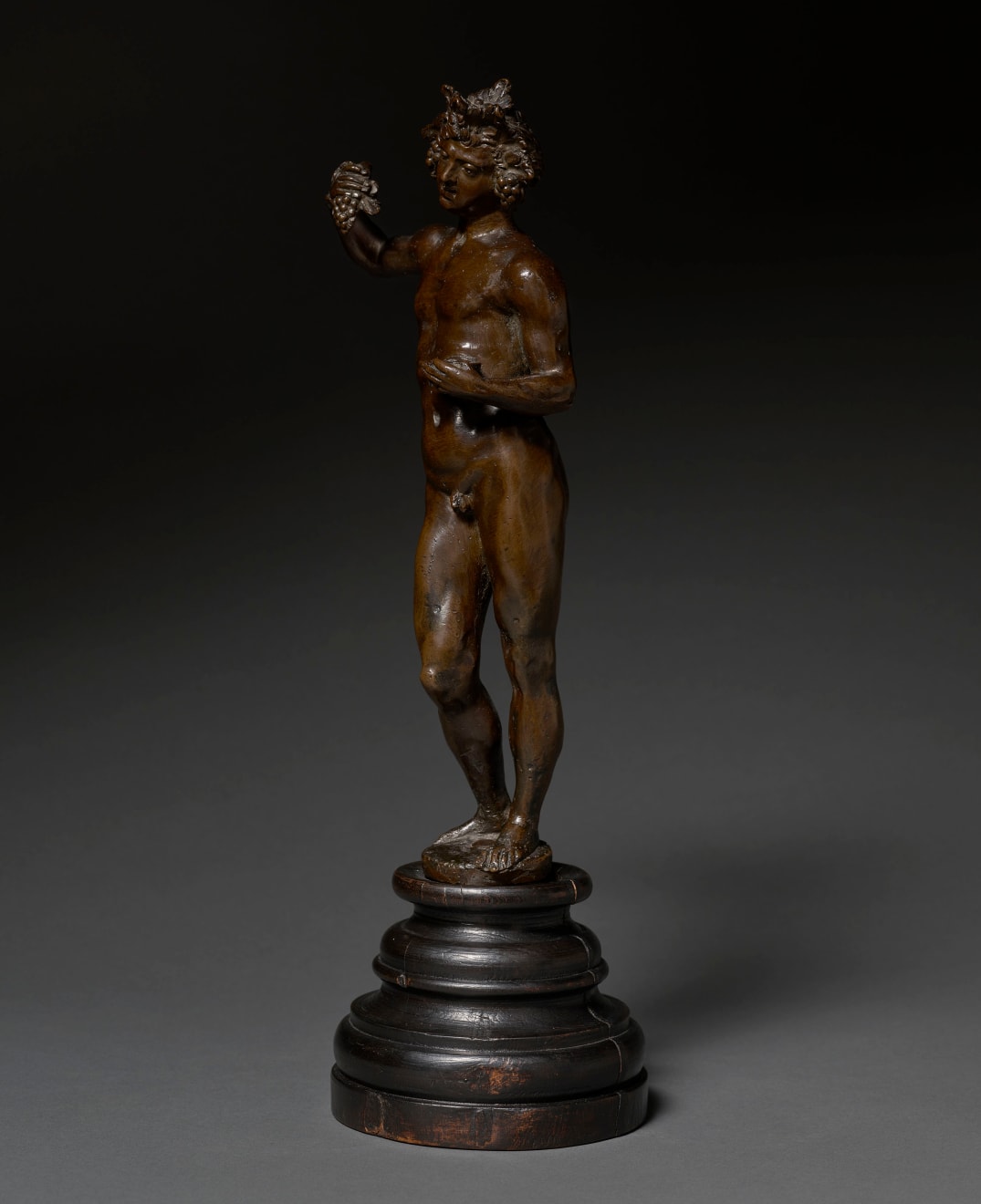Niccolò Roccatagliata
13 1/8 x 4 3/8 x 2 3/4 in
33.5 x 11 x 7 cm
Bacchus:
12 5/8 x 5 1/8 x 3 1/8 in
32 x 13 x 8 cm
Further images
The size, round base with a central pin, and the focus on form, reveal the original purpose of these two wonderful statuettes as the crowning figures of Andirons. Originally elements which would have topped a larger, ornamental, andiron composition - likely made up of winged harpies, vases, and animalia.
The figure of Ceres, her hair flowing in wavy dynamic locks, turns in a soft, serpentine contrapposto to her left. Her hands, her right resting on her hip, her left clasped to her breast, both hold abundant sheaf’s of wheat, symbolic of her role as goddess of fertility, agriculture, and grain crops. Her pose is derived from antiquity from the Greco-Roman examples of the Venus Pudica type.
The figure of Bacchus takes the form of a lithe youth, his right arm raised clasping a bunch of grapes, in his left a wine cup is held to his chest. Of note is the particular rendering of the facial features, the eyes and pinched mouth, as well as the beautifully modelled curled locks of hair, crowned by a wreath of grapes and vines. The ingenuity of the composition, the exacting study of the human anatomy, and quality of the finish of the bronze, make it comparable to similar works by the hand of Nicolò Roccatagliata (1593-1636).
The figure and pose of Bacchus follows the type popularised in Florence in the Renaissance, firstly by Michelangelo (1475-1564) in his famous marble Bacchus of 1496-7 in the Bargello, but equally Jacopo Sansovino’s (1486-1570) slightly later Bacchus (c.1514). Sansovino’s sculpture of the subject became his most copied work and acted as a cornerstone of inspiration to artists working in Florence including Baccio Bandinelli (1488-1560) and Giambologna (1529-1608). The Venetian execution of a subject of Florentine genus can be explained by the fact that Sansovino left Florence for Venice in around 1527 – where he became much revered, effectively as Michelangelo’s heir. In Venice, Sansovino made a lasting impression on the sculptors of the city, influencing a whole school of artists proficient in small bronze statuettes of the type synonymous with Venetian sculpture of the 16th and 17th centuries. These include notably, Sansovino’s celebrated pupil Alessandro Vittoria (1525-1608), as well as Girolamo Campagna (1552-1625, Vittoria’s principal rival who trained under Sansovino and his pupil Danese Cattaneo 1509-1572) as well as other members of Sansovino’s ‘School’: Tiziano Aspetti (1559-1606) and Nicolò Roccatagliata (1593-1636).
Firedogs or andirons were ornamental yet functional objects which would stand either side of the fireplace and hold burning logs above the floor in order to allow an updraft of air. Popular from at least the 16th century in the Veneto, these bronzes would often be surmounted with sculptures of classicised figures depicting characters such as Jupiter (see the andiron by Roccatagliata in the collection of The National Museum of Scotland Edinburgh, formerly Bute Collection. From the 19th century onward however, the crowning figures being remarkable sculptures in their own right, they were often separated from their firedogs so as to make them statuettes, thus increasing their appeal to collectors.
Such bronzes, often made up of multiple elements, are an interesting study in the relationship between the leading sculptors active in the region of this period, such as Roccatagliata, as well as Campagna, Vittoria, and the foundries. Verona and Venice were the centre of Italian bronze production in the sixteenth century and foundries such as those of the Campanato, Alberghetti and de Levis families – were experts in such technical casting and specialised in such ornamental artefacts alongside the production of bells, mortars, inkstands, and door-knockers.
Provenance
Private collection, France, to 2019
Literature
Motture, P. “The Production of Firedogs in Renaissance Venice”, in: D. Pincus (Ed.), Large Bronzes in the Renaissance, National Gallery of Art, Washington, 2003, pp. 276-307
Join our mailing list
* denotes required fields
We will process the personal data you have supplied to communicate with you in accordance with our Privacy Policy. You can unsubscribe or change your preferences at any time by clicking the link in our emails.














